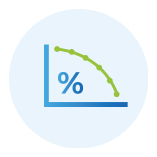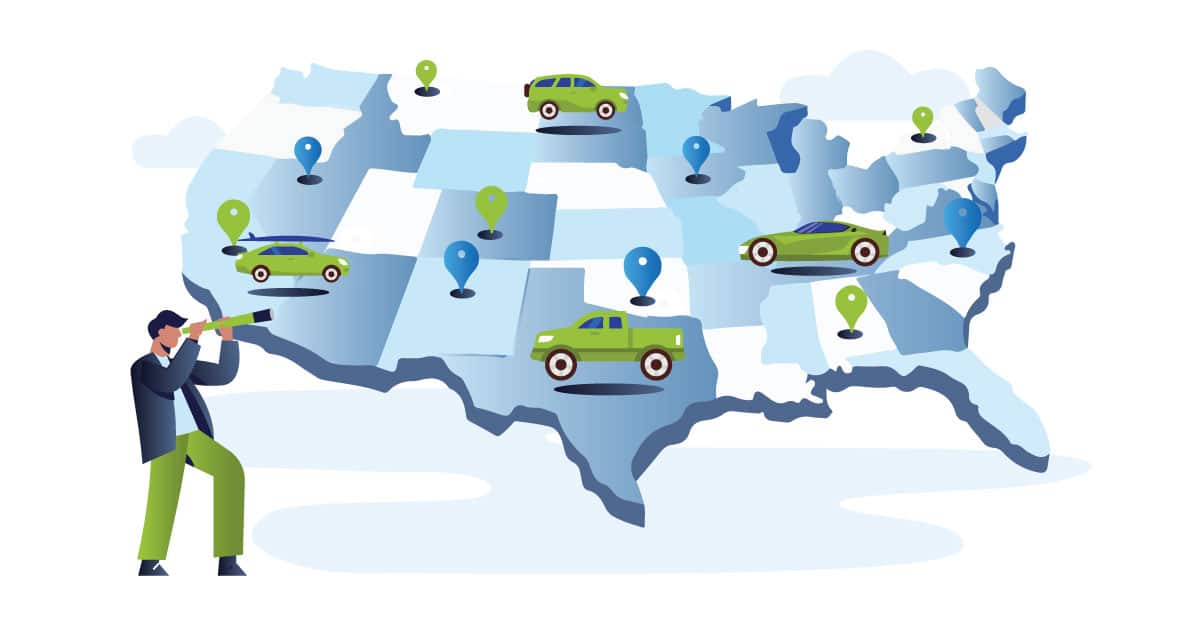2021 proved to be another record-breaking year for auto loan refinancing.
Consumers saved more, reduced their interest rates by a greater margin, and even saw their vehicle equity improve as used car prices skyrocketed — all while the COVID-19 pandemic entered its second year and continued to change the economic landscape across the world. From microchip shortages to loan delinquencies to inflation, it’s hard not to notice the influence the coronavirus has had on the entire auto industry.
While our inaugural report focused on the impact of the pandemic, this year’s edition brings to light the factors that determine when it makes sense to refinance your auto loan and how much a borrower can save by doing so.
RateGenius analyzed a sample of more than 300,000 funded loans, i.e. successful auto refinance applications made by our customers between 2013 and 2021. We also included 2021 proprietary data from AUTOPAY which merged with RateGenius under The Savings Group in July 2021.
Combined, RateGenius and AUTOPAY saved borrowers $56.4 million on their auto loans last year.
So, how much did borrowers save by refinancing their auto loans? What factors contributed to higher savings from refinancing? And how did borrowers get the most out of their refinance?
Let’s dive right in.
Key findings
2021 Auto Loan Refinancing At A Glance

$1,158
Average annual savings by refinancing auto loans in 2021

7%
Average interest rate reduction for every refinanced auto loan

16.7
Number of months into auto loan before refinancing

56%
Percentage of borrowers who saved $50 to $149 per month

670
Average credit score of auto refinance borrowers last year

$153
How much Tesla owners saved every month after refinancing
Savings
- In 2021, customers saved an average of $1,158 per year after refinancing their auto loans. This is a 16% increase compared to 2020 and the highest amount since our records began in 2013.
- One in five (19%) borrowers who refinanced their auto loan had their monthly payment reduced by $150 or more.
- Over half of all borrowers (56%) saved between $50 and $149 on their monthly car loan payments.
Interest Rates
- The average interest rate on an original auto loan (pre-refinance) was 14% while the rate after refinancing was reduced by half (7%).
- Borrowers in the Prime credit tier lowered their auto loan rates from 11.9% to 5.1%, and Super Prime borrowers from 6.8% to 3.4%.
- The average interest rate reduction after refinancing was 7%, the greatest difference since 2013.
Credit Scores
- The average credit score of all applicants who successfully refinanced in 2021 was 670.
- Borrowers with scores between 601 and 660 (Nonprime) saved $99 a month after refinancing, only one dollar less than people in the Prime segment (scores 661 to 780), who saved $100/month.
- Those in the Super Prime credit category (781 to 850) saved the least amount after refinancing, $85 per month on average.
Vehicles
- Once again pickup trucks delivered the biggest monthly savings in auto loan refinancing averaging $131, followed by SUVs ($113), and sports cars ($103).
- Minivans and station wagons ranked last among vehicle classes with an average monthly savings of $75.
- The vehicle brand with the highest refinance savings was Tesla, reducing their average monthly payments by a whopping $153 — that’s more than $1,800 in savings per year. However, Tesla owners still pay the most on their car loans even after refinancing at $720 per month.
People
- Borrowers in Hawaii ($123), Nevada ($111), Louisiana ($107), California ($106), and Texas ($105) saw the greatest reductions in monthly repayments post-refinancing.
- Borrowers in Lancaster, California saved the most after lowering their car payments by $138 per month, followed by Odessa, Texas where borrowers saved $128.
- Workers in skilled trades were among the biggest savers in auto refinancing. Welders reduced their auto loan payments by $128, construction workers by $108, and electricians by $103.
Auto Refinance Savings Reach New Record High in 2021
Auto refinance borrowers saved an average of $1,158 per year, or about $97 per month. This is 16% higher than in 2020 and a new record, surpassing 2015’s average annual savings of $1,031.
More than half of all borrowers (56%) saved between $50 and $149 on their monthly car loan payments.
Additionally, the percentage of borrowers who save over $100 per month has been steadily increasing since 2018. In 2021, 41% of borrowers saved more than $100 monthly after refinancing their car loans compared to 33% the year before.
One in five (19%) borrowers had their payment reduced by $150 or more.
Why Did Borrowers Save More Last Year?
There are three key data points that can help explain why borrowers had greater auto refinance savings in 2021:
- Pre-refinance interest rates were higher. The average interest rate before refinancing was 13.9% in 2021, compared to 10.8% in 2020. After refinancing, borrowers reduced their interest rates by 7.1%.
- Loan-to-value ratios improved. The average retail LTV in 2021 93.1% and 102% in 2020. It’s the lowest LTV recorded since 2013. The spike in used car values helped, but it’s also possible more borrowers are purchasing and refinancing vehicles that hold their value better.
- Refinanced vehicles were more expensive. A higher share of pricier vehicles were refinanced. SUVs and trucks accounted for over half (56.4%) of all refinanced loans. The average amount financed in 2021 was $26,070 and $18,518.09 in 2020.
However, these aren’t the only factors that can influence how much you can expect to save after refinancing.
How Does Your Credit Score Impact Auto Refinance Savings?
Contrary to popular belief, a high credit score doesn’t automatically translate into higher savings when refinancing a car loan. In fact, borrowers in the Super Prime category (781 to 850 credit score) saved the least after refinancing, an average of $85 per month.
Nonprime borrowers (601 to 660 credit score) saved $99 per month, just one dollar less than borrowers in the Prime credit tier (661 to 780).
But why? Lenders look at more than just a credit score to determine whether or not they will offer an auto refinance loan, and with what rate and terms. Borrowers can generally expect higher savings if any or all of the following have occurred since taking out the original auto loan:
- Improved credit score. Moving into a higher credit tier can help secure lower interest rates when refinancing.
- Interest rates dropped. If the market changes and interest rates go down, that can help borrowers qualify for a lower rate even if their credit situation hasn’t changed much since the original loan.
- Paid down auto loan balance. More positive equity in a vehicle helps the loan-to-value ratio which can help borrowers qualify for a more competitive interest rate.
The more the above applies to a borrower’s situation, the more they can expect to save when refinancing. However, every lender is different, and there are other factors to consider (like income, existing debt, the condition of your car, etc.) that can also impact a credit decision.
Interest Rate Difference Is the Largest on Record
The average interest rate of original auto loans (pre-refinance) was 13.9% while the average for refinanced loans was 6.8%.
Both are the highest rates recorded in eight years — but so is the rate reduction. At 7.1%, the interest rate difference between the original and refinance auto loans in 2021, surpassed the previous year’s record, 5.5%.
Predictably, borrowers in the Prime and Super Prime credit categories had lower interest rates before and after refinancing their loans compared to the Nonprime and Subprime groups. On average, Prime borrowers lowered their auto loan rates from 11.9% to 5.1%, and Super Prime from 6.8% to 3.4%.
While better credit scores do help lock in a better interest rate, the rate spread shrinks if the borrower’s credit score is above 660. Super Prime borrowers reduced their interest rate by 3.4% and Prime by 6.8% while Nonprime and Subprime reduced theirs by 7.9% and 8.1%, respectively.
Did Auto Refinance Interest Rates Increase Over the Last Year?
Interest rates were historically low throughout 2021, but among the loans that successfully completed the refinance process, interest rates were higher.
Remember: A higher credit score does not necessarily mean higher savings after refinancing. Unless the borrower’s credit score has increased, interest rates have dropped, or loan-to-value has improved since getting the original auto loan, refinancing may not be worth it.
Additionally, rates have been low since early 2020. It’s possible that borrowers in the higher credit categories are getting auto loans with competitive interest rates from the get-go. According to Experian’s State of the Automotive Finance Q3 2021 report, the average interest rate for new vehicle financing was 3.58% for Super Prime borrowers and 3.64% for Prime.
Is There a “Best Time” to Refinance Your Auto Loan?
Borrowers refinanced their auto loans sooner last year, 16.7 months into their loan compared to 17.3 months in 2020.
But does timing your auto loan refinance impact how much borrowers save?
Overall, refinancing after 11 to 15 months into the original auto loan appears to yield the highest savings. In 2021, borrowers who refinanced during this period saved $85 to $92 on their monthly loan payments and between $1,100 and $1,700 over the lifetime of the loan.
There are two things to keep in mind when considering refinancing an auto loan:
The earlier into the loan, the less borrowers save on monthly payments. While savings are still possible, the borrower’s finances likely haven’t changed significantly since the original loan, so refinancing isn’t likely to be much more attractive in terms of interest rates and monthly loan payments.
The later into the loan, the less borrowers save overall. If the borrower improves their credit and builds equity in their vehicle, their monthly payment is likely to decrease substantially. But, refinancing later often means extending the loan term, so it’s likely the borrower will have paid more by the time they’re done repaying the refinance loan.
According to a TransUnion report, 75% of consumers were motivated to refinance their auto loans to lower their monthly loan payment in 2020. Most auto refinance borrowers are “payment shoppers,” meaning they’re more interested in saving money on their monthly car loan payments — not how much they’ll pay over the life of the loan.
Auto Refinance Savings by Vehicle Class, Make, and Model
Once again pickup trucks delivered the biggest savings after refinancing: $131 per month. They’re not only expensive — the average transaction price for a mid-size pickup truck in November 2021 was $41,417 — they also hold their value. These factors, among others, can help borrowers get better loan terms when refinancing and lower their monthly auto loan payments.
SUVs had the second-highest average monthly savings after refinancing ($113), followed by sports cars ($103). Minivans and station wagons ranked last among vehicle classes with an average of $75.
Teslas drove the biggest savings of all car makes. The owners of these electric cars taking the world by storm saved an average of $153 per month after refinancing their car loans. That’s more than $1,800 in savings per year.
Six out of the top 10 models with the biggest monthly savings were pickup trucks. In fact, trucks took the top three spots. Both Ram 3500 and GMC Sierra 1500 owners saved over $150 per month after refinancing while Chevrolet Silverado 2500 owners just missed the mark with $145 in monthly savings.
Why Did Tesla Owners Save So Much After Refinancing?
Tesla owners had by far the highest original loan amounts – $50,300 on average — higher than Porsche ($47,600) and Maserati ($44,300). Therefore, the amount refinanced last year was also high, roughly $42,100.
However, Teslas also have the largest monthly car loan payments before and after refinancing ($873 and $720). Compare that to the make with the second-highest original auto loan payment, Audi. Monthly payments for Audi drivers dropped from $743 per month to $641 after refinancing.
Original loans on Tesla vehicles had a very low average interest rate, 6.2%, which is lower than many borrowers’ refinance rates. After refinancing, Tesla owners enjoyed rates as low as 4%. It’s also worth noting that Tesla owners have a very high average credit score of 754, significantly higher than any other car brands.
Timing may have also helped. Teslas were refinanced a lot sooner than other vehicles, with an average of 13 months into the existing auto loan, at least four months sooner than the overall average.
Finally, Teslas had an average loan-to-value ratio of 86%, on par with luxury brands like Maserati and Porsche, and at least 10 points higher than more popular brands like GMC (96%) or Ford (98%).
Borrowers Who Scored the Biggest Auto Refinance Savings
How much a borrower pays for a car loan depends on more than just their credit score and income. Outside factors like a state’s economic health, local lending laws, and competition can also influence interest rates.
The five states with the highest average monthly payment savings were Hawaii ($123), Nevada ($111), Louisiana ($107), California ($106), and Texas ($105).
Of the cities that saw the largest savings, the top 10 are all located in Texas and California.
Borrowers in Lancaster, California lowered their car payments by $138 per month. Odessa, Texas came in second with a monthly reduction of $128.
Does Your Occupation Matter When Refinancing Your Auto Loan?
While occupation does not directly impact a borrower’s auto refinance application, data showed some interesting patterns when it comes to monthly savings and occupations.
Workers in skilled trades were among the top 10 occupations that saved the most after refinancing. Welders reduced their auto loan payments by $128, construction workers by $108, and electricians by $103.
First responders also made the list. Police officers reduced their monthly payments by $108 on average, while nurses saved an average of $107 after refinancing their auto loan.
These occupations have three things in common that may explain why they saved so much last year: high auto loan balances, high interest rates pre-refinancing, and expensive vehicles.
For example, welders saved the most, but they also had both the highest loan balance ($34,000) and interest rate (13.6%). The other occupations with the highest auto loan balances at the time of refinancing were police officers ($33,200), engineers ($31,200), nurses ($30,500), mechanics ($30,300), and construction workers ($30,000).
After welders, the occupations with the highest interest rates on their existing auto loans were carpenters (13.1%), plumbers (12.4%), transport and logistics professionals (12.4%), and electricians (12.0%).
More than half (54%) of carpenters who refinanced their vehicle were pickup truck owners, as were 47% of welders.
Police officers’ preferences were split between SUVs (38%) and pickup trucks (33%). They also share an affinity for fast cars; 12% of refinanced loans by police officers were for sports and muscle cars, more than any other occupation.
Among nurses, 58% of all vehicles refinanced were SUVs, the highest percentage across occupations.
Getting More Out of Your Auto Refinance Loan
Whether you’re hoping to lower your interest rate or pay off your car early, the goal is still the same — to get a better car loan. Here’s what you can do to get the most out of auto loan refinancing:
- Check your credit. Before submitting an application, take a look at your credit profile and score. Has your credit score improved since you took out the original auto loan? Are there any errors on your credit report that could hurt your chances to qualify for a competitive loan?
- Research rates. You can look up current auto refinance rates, calculate your savings, and even compare estimates without a hard credit check.
- Compare multiple loan offers. Every bank, credit union, and financing company has their own set of guidelines that determine whether a borrower is eligible for a loan and at what terms. So why settle with the first offer you get? Fortunately, multiple credit inquiries for the same type of loan do not hurt your credit score if completed within the rate shopping period.
With over $1,100 in annual savings, refinancing your auto loan can do more than just lower your monthly car loan payment. It can help ease the financial burden of owning a vehicle and get you closer to your financial goals too.
For more information about the report including additional insights, contact us at media@rategenius.com.
Methodology
Analysis includes proprietary data from RateGenius and AUTOPAY customer applications for auto loan refinancing made between January 1, 2021, and October 31, 2021, for State of Auto Refinance: 2022 Report, as well as RateGenius customer application data from 2013 to 2020. This dataset included a sample of over 300,000 anonymized funded auto loan refinance applications from 2013 to 2021. We examined annual savings, changes in interest rates, average credit scores, and amount of debt, breaking the figures down by state, city, and vehicle make, model, and class.


;)









